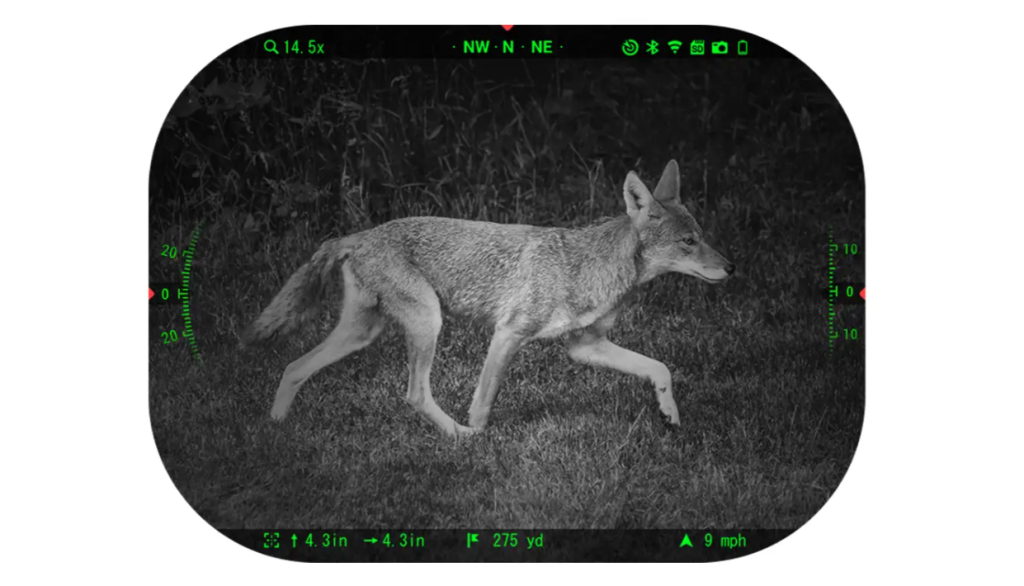When it comes to shooting or spotting in low-light conditions, two types of optics dominate the conversation: digital night vision and thermal optics. Both technologies give shooters and hunters the ability to see in the dark, but they operate in completely different ways — and the one you choose can significantly affect your performance depending on your environment and intended use.
In this blog, we’ll break down the differences between digital night vision and thermal optics, outline their pros and cons, and help you decide which is the best option for your application.
How Digital Night Vision Works
Digital night vision works by collecting and amplifying available light (including infrared light) through a digital sensor. It displays the image on a screen — much like a camera — rather than directly through glass optics.
Modern digital night vision units use CMOS or CCD sensors, and most come with built-in IR illuminators to enhance visibility in complete darkness. Unlike older generations of analog night vision (like Gen 1 or Gen 2), digital night vision can also record footage, provide on-screen menus, and often connect via Wi-Fi or apps.
How Thermal Optics Work
Thermal optics detect heat signatures from people, animals, vehicles, and objects. Everything with a temperature above absolute zero emits infrared radiation, and thermal scopes translate that invisible heat into a visible image — usually in grayscale or color-coded palettes like white hot, black hot, or red hot.
Because thermal optics don’t rely on light at all, they can be used in complete darkness, through smoke, light brush, fog, and even during the day.
Key Differences Between Digital Night Vision and Thermal Optics
| Feature | Digital Night Vision | Thermal Optics |
| Detection Method | Amplifies available light (IR) | Detects heat signatures |
| Works in Total Darkness | Yes (with IR illuminator) | Yes |
| Daytime Use | Yes | Yes |
| Image Type | More detailed, like a black-and-white or color video | Heat-based, silhouette style |
| Target Identification | Better at confirming what you’re looking at | Great at detecting, less detail |
| Range | Typically shorter (100–300m) | Longer range (300–1000m+) |
| Penetrates Obstructions | No | Yes (through fog, smoke, light brush) |
| Price | More affordable | More expensive |
Pros and Cons of Digital Night Vision
Pros:
- Cost-effective: Much more affordable than thermal, making it great for budget-conscious buyers.
- Detailed visuals: You can see clear outlines and more definition — ideal for identifying animals or objects.
- Day/night versatility: Many units can switch between day and night modes.
Cons:
- Relies on light: Needs some ambient light or an IR illuminator — and IR light can potentially give away your position.
- Shorter range: Detection and image clarity drop off beyond a few hundred meters.
- Obstruction sensitivity: Can’t see through smoke, fog, or foliage as thermal can.
Pros and Cons of Thermal Optics
Pros:
- Superior detection: Excellent for spotting heat-emitting targets at long range, even in pitch black.
- All-weather capability: Works in fog, dust, rain, and smoke where digital NV struggles.
- No IR signature: Passive technology that doesn’t reveal your position with a light source.
Cons:
- Expensive: Thermal optics are often twice or even three times the price of digital night vision.
- Limited detail: Harder to positively identify animals or objects — everything is a heat silhouette.
- Slower refresh rates: Some lower-end thermal scopes can feel laggy or less responsive.
Which Is Best?
The answer depends on your specific needs:
Choose Digital Night Vision if:
- You want a more budget-friendly optic for shooting, spotting, or pest control.
- You need to identify animals, people, or objects at moderate distances.
- You’re mostly operating in semi-lit conditions or can use IR lighting.
- You want the ability to record footage or stream your hunts.
Choose Thermal Optics if:
- You need to spot targets quickly at longer ranges.
- You’re working in harsh conditions like fog, smoke, or heavy brush.
- You’re doing feral pest control, where speed and detection matter more than identification.
- You have the budget to invest in high-performance gear.
Real-World Use Cases
- A farmer trying to protect livestock from feral predators at night might benefit more from thermal optics, thanks to the fast detection ability and long-range spotting.
- A hunter who needs to identify and distinguish between species before taking a shot may prefer digital night vision, which provides more image clarity.
Final Thoughts
Both digital night vision and thermal optics have come a long way in recent years, and each has its own strengths. While thermal is unmatched for detection in total darkness and adverse conditions, digital night vision offers better clarity, more features, and a friendlier price point for everyday shooters and hunters.
If budget allows, many professionals run both systems in tandem — using thermal for scanning and night vision for shooting. But if you’re starting out and need to choose one, base your decision on how you shoot, where you shoot, and what you’re shooting at.
For many shooters, the best setup is a combination: thermal for detection, digital night vision for identification. Understanding the strengths of each helps you choose the right gear for your specific needs, whether you’re hunting pests, conducting surveillance, or navigating in the dark.

